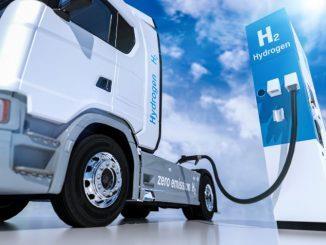
Two specific issues have been identified with hydrogen that the truck sector needs to deal with: firstly, the development and construction of efficient fuel cells. Then secondly, the distribution of hydrogen to ensure that trucks can be refuelled safely and quickly.
By coincidence, two significant developments took place recently to address both issues.
In January MT made reference to the joint venture between Daimler Trucks and Volvo Group to develop and produce hydrogen fuel-cell systems. At the end of April, the chief executives of both companies jointly announced how they would go about this process. The joint-venture company was launched in March and was given the name cellcentric.
Both companies believe that there will be both battery electric trucks, like those appearing already, and fuel cell powered vehicles. Fuel cells will power vehicles where there is a need for long range, fast refuelling and high payload. Cellcentric was formed to speed up the development process.
Martin Lundstedt, Volvo Group president and chief executive explained that 2040 was the latest date by which all Volvo products should be CO2 free, while Daimler Truck chief executive Martin Daum explained that the truck industry fully agreed with the 2016 Paris Agreement on Climate Change and the EU Green Deal, which sets out to make Europe climate neutral by 2050. “The fuel cell is imperative for this ambitious timetable," said Daum. “We need a second source of energy as cars, trucks, buses and other vehicles all need electricity. We are reducing costs step by step."
Pre-series production is already under way and customer trials are due to begin using Daimler, Volvo Trucks and Renault Trucks vehicles in the next three years. Then by 2025, series production will be under way in a new factory. The location for this new plant has yet to be announced.
Daum laid out three essential elements – an attractive vehicle offering, hydrogen fuelling infrastructure and cost parity with diesel powered vehicles. Regarding infrastructure, Daum said, “Infrastructure needs massive investment and it has to start now. We need energy company and political involvement.”
Read more
- Daimler/Volvo fuel cell joint venture a giant leap towards electric future
- Tevva joins forces with energy firm Vattenfall to offer operators electricity and hydrogen infrastructure
- Government urged to back hydrogen fuel cells after bringing forward carbon emissions target
He believes that around 1,000 fuel stations will be needed across Europe by 2030 - “And it must be 'green' hydrogen, or it will be better to go on burning diesel.”
To be viable, Lundstedt believes that the price of 'green' hydrogen – produced from renewable sources, must be around €3 to €4 per kg. Pricing is clearly a concern. As Daum pointed out, zero emission trucks will be more expensive than diesel models and the risk that diesel powered vehicles could undermine those powered b 'green' hydrogen is one that needs to be taken seriously.
Infrastructure to distribute and dispense hydrogen safely is key to the take-up of fuel-cell powered vehicles. We take high-pressure diesel pumps at re-fuelling stops for trucks for granted. The design is the same across Europe and beyond and it will need to be the same for hydrogen too. That is the concern of the MultHyFuel project, a public/private partnership facilitated by the EU. The project is being co-ordinated by Hydrogen Europe, in collaboration with Air Liquide, ENGIE Lab CRIGEN, HSE, INERIS, ITM Power, Kiwa, Snam, Shell and ZSW.
Even though the UK has left the EU, both ITM Power and the HSE are providing valuable input to the project. Sheffield-based ITM Power manufacturers electrolysers to produce hydrogen from electricity, which can then be used to produce electricity in hydrogen fuel cells.
Hydrogen Europe was established in 2008 and has over 185 members, while its research group has some 83 members. Its remit goes beyond road transport into a wide range of industries that need hydrogen including railways and shipping.
MultHyFuel will cover a range of activities including standards, safety, education and consumer awareness. From a transport perspective its specific interests will be the regulation and safety of fuel dispensers for pressurised hydrogen gas, recognising that some countries have no regulations for hydrogen fuelling stations. It will consider the design of the vehicle connectors, co-location of hydrogen dispensers next to other forecourt fuel pumps and all the safety issues around dispensing flammable fuels.
With involvement from the project stakeholders, it will use the results to produce a report in 2023. Time will be tight if fuel cell vehicles are to hit the road in 2025.














